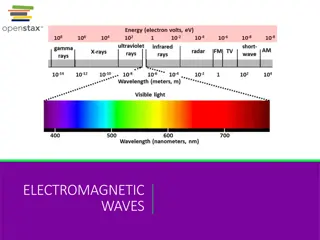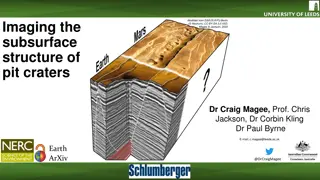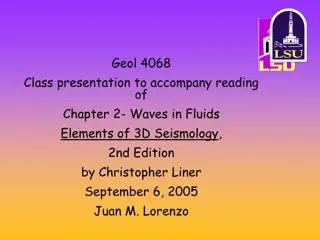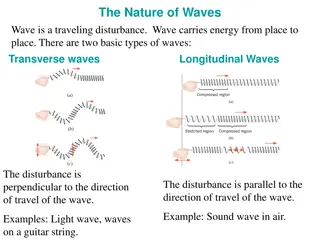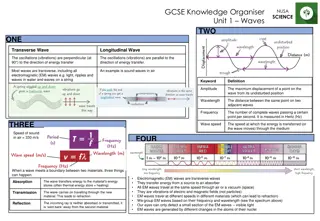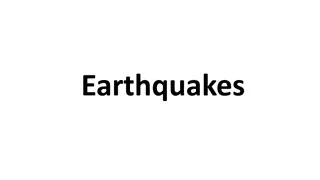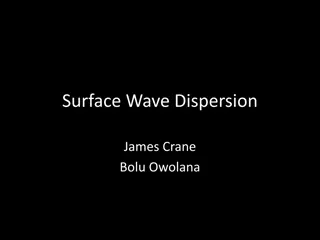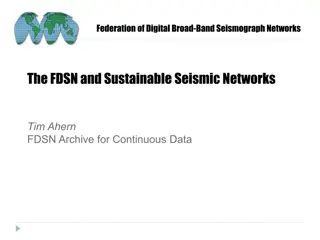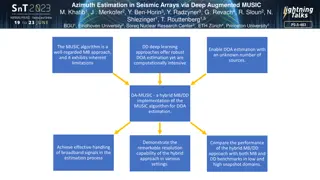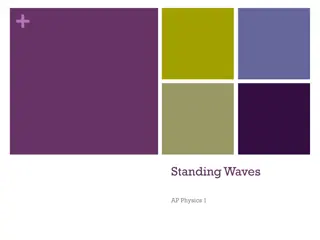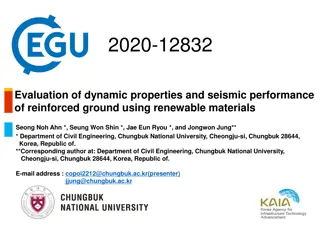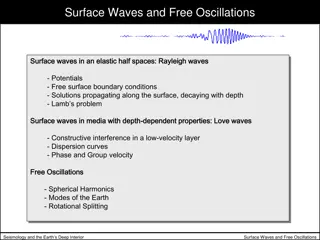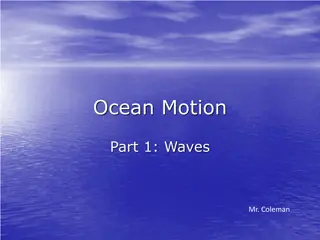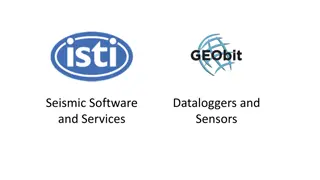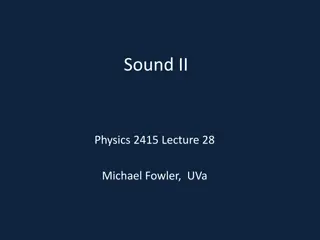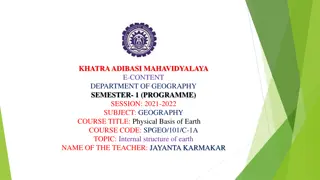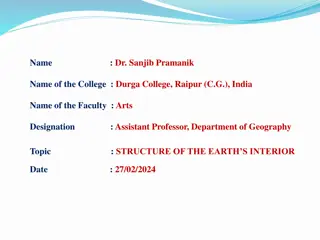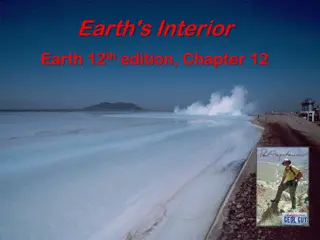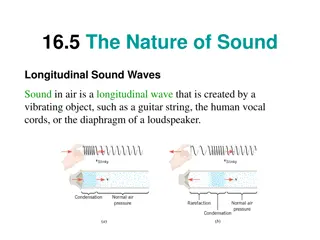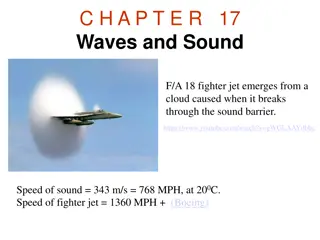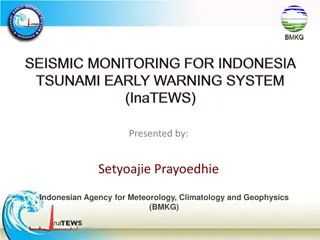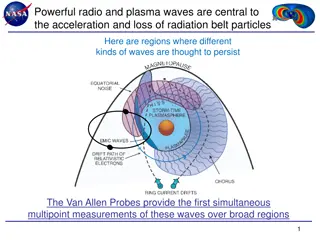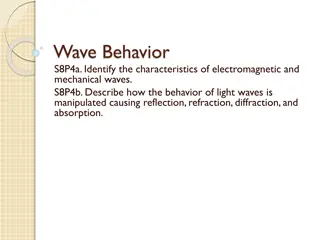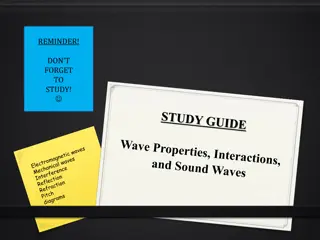Understanding Brain Waves: Frequencies and Behaviors
Brain waves are electromagnetic signals produced by the brain, categorized by frequencies into Delta, Theta, Alpha, and Beta waves, each associated with different states of consciousness and behaviors. These waves play a crucial role in our brain's energy utilization and overall functioning.
1 views • 11 slides
Understanding Electromagnetic Waves: Maxwell's Contributions and Hertz's Observations
James Clerk Maxwell's groundbreaking work in the 19th century revealed the fundamental nature of light as an electromagnetic wave. His equations formed the basis for understanding the interplay between electricity and magnetism, predicting the existence of electromagnetic waves. Heinrich Hertz furth
4 views • 24 slides
Understanding Sound Waves and Human Hearing
Sound waves are longitudinal waves where particles move in the same direction. The human body hears sounds through vibrations reaching the cochlea, which produces electrical signals for the brain to interpret. Properties of sound waves include traveling through various mediums at different speeds. F
2 views • 10 slides
Understanding Earth's Interior through Seismic Waves: Part 1
Seismic waves provide crucial evidence about Earth's composition and structure. By analyzing the behavior of primary, secondary, and surface waves, scientists can determine the different layers and materials within the Earth. Primary waves travel through both solid and liquid parts, while secondary
10 views • 10 slides
Exploring Types of Waves and Energy Transport
Discover the various types of waves such as transverse, longitudinal, surface, and electromagnetic waves, along with their characteristics and applications in energy transportation. Learn about the differences between mechanical and electromagnetic waves, how waves transmit energy, and their signifi
3 views • 10 slides
Alameda Hospital Seismic Planning and Financial Committee Meeting Summary
The Alameda Hospital Seismic Planning and Finance Committee met to review capital cost estimates, consider various seismic options, and assess financial projections. The Joint Planning Committee (JPC) collaborated to evaluate maintaining the current footprint, reconfiguring the hospital, and optimiz
0 views • 23 slides
Exploring Subsurface Structures of Pit Craters Through Seismic Reflection
Discover the technique of seismic reflection imaging to unveil the subsurface structures of pit craters on Earth and Mars. Follow the analysis of seismic data to map pit craters and their connections to geological features like dykes and fault jogs, shedding light on the formation processes of these
0 views • 11 slides
Understanding Waves: A Visual Exploration
Explore the fascinating world of waves through visually engaging images and interactive clickers. Learn about different types of waves, including longitudinal and transverse waves, and discover what waves carry - energy, not matter. Delve into the concepts of mechanical and electromagnetic waves, an
1 views • 37 slides
Understanding General Plane Waves in Electromagnetic Theory
This study focuses on the analysis of general plane waves in electromagnetic theory, covering topics such as the general form of plane waves, Helmholtz equation, separation equation, wavenumber vector, Maxwell's equations for plane waves, and the symbolic representation of plane waves. The content d
0 views • 41 slides
Understanding Seismic Source Parameters in Earthquake Dynamics
The seismic source parameters in earthquake dynamics involve describing a fault as a discontinuity causing displacements, requiring a complex treatment of forces. The Earth's equilibrium necessitates a specific system of forces to explain displacements along faults. The seismic moment tensor, consis
4 views • 32 slides
Understanding Interference and Beats in Waves
Explore the fascinating phenomena of interference and beats in waves, where overlapping waves interact to create patterns of constructive and destructive interference. Witness how sound waves can also produce beats when interfering in time, resulting in a slow envelope effect. Delve into the princip
0 views • 40 slides
Gravity Waves as a Mechanism of Coupling Oceanic and Atmospheric Acoustic Waveguides to Seismic Sources
Direct excitation of acoustic normal modes in horizontally stratified oceanic waveguides is negligible for shallow earthquakes due to velocity disparities. This study evaluates the contribution of scattering by hydrodynamic waves in generating abyssal T-waves. The research explores the role of scatt
1 views • 6 slides
Understanding Waves in Fluids: Geol 4068 Class Presentation
This presentation accompanies the reading of Chapter 2 on Waves in Fluids from "Elements of 3D Seismology" by Christopher Liner. It covers topics like fluid properties, elastic moduli, acoustic wave equations, seismic materials, and key physical parameters of acoustic waves. The importance of veloci
0 views • 18 slides
Exploring the Nature of Waves and Sound
Understanding the nature of waves, both transverse and longitudinal, and their properties such as amplitude, wavelength, and frequency. Delve into the world of water waves, periodic waves, and the speed of waves on a string. Learn about the longitudinal nature of sound waves, the audible frequency r
0 views • 16 slides
Understanding Waves: Properties, Behaviors, and Applications
Waves come in different forms - transverse and longitudinal - each with distinct characteristics and behaviors. Understanding concepts like amplitude, wavelength, frequency, and wave speed is crucial in grasping how waves transfer energy through different materials. The interaction of waves with bou
0 views • 9 slides
Determining OBS Clock Drift Using Seismic Interferometry
Determining clock errors in Ocean Bottom Seismometers (OBSs) is crucial for accurate seismic data recording. This study presents a method using ambient seismic noise and seismic interferometry to correct clock drift in OBSs. The program developed employs Python/Fortran to analyze seismic data direct
0 views • 10 slides
Understanding Waves: Characteristics and Types Explained
Explore the wave nature of sound and electromagnetic radiation, distinguishing between electromagnetic and mechanical waves. Waves are energy-carrying disturbances that do not transport matter. Mechanical waves require a medium for energy transfer, while electromagnetic waves can travel through spac
0 views • 26 slides
Understanding Earthquakes and Seismic Waves
This lecture delves into the nature and origin of earthquakes, discussing seismic waves, measurement techniques, effects of earthquakes on various Earth systems, and the relationship between earthquakes and plate tectonics. The content touches on topics like the impact of earthquakes on biosphere, h
0 views • 34 slides
Understanding Surface Wave Dispersion in Seismic Exploration
Surface wave dispersion, explored by James Crane and Bolu Owolana, plays a crucial role in seismic studies. This phenomenon, involving waves spreading at varying speeds, helps evaluate subsurface characteristics based on wavelength. By studying surface waves, researchers can determine velocity, dens
0 views • 14 slides
Federation of Digital Broad-Band Seismograph Networks: Advancing Global Seismic Monitoring
The Federation of Digital Broad-Band Seismograph Networks (FDSN) was established in 1985 to enhance seismic monitoring capabilities worldwide. FDSN collaborates with national institutions, coordinates new station locations, and promotes standardization of seismic instruments. Despite lacking inter-g
0 views • 21 slides
Federation of Digital Broad-Band Seismograph Networks (FDSN) Overview
FDSN, founded in 1985, coordinates digital broad-band seismic networks globally to enhance seismic monitoring and research. It promotes site selection, data exchange, and instrument standardization, facilitating the installation of seismic stations across various scales to support earthquake studies
0 views • 15 slides
Seismic Site Characterization in Metropolitan Vancouver
The Greater Vancouver area faces high seismic risk due to its population density and critical infrastructure. Ground shaking during large earthquakes depends on various factors including the earthquake source, material properties, and site conditions. Efforts are being made to map seismic hazards, u
0 views • 13 slides
Azimuth Estimation in Seismic Arrays via Deep Augmented MUSIC
This study introduces DA-MUSIC, a hybrid approach combining traditional MUSIC algorithm with deep learning for robust Direction of Arrival (DOA) estimation in seismic arrays. The methodology improves resolution and handles broadband signals effectively. Utilizing non-synthetic seismic data collected
0 views • 4 slides
Understanding Traveling Waves: Types, Properties, and Equations
Explore the world of traveling waves, including mechanical, electromagnetic, and matter waves. Learn about transverse and longitudinal wave motion, the speed of waves in strings, wave frequency, wavelength, and speed relationships, as well as wave equations for non-repeating waves over space and tim
1 views • 30 slides
Understanding Standing Waves in Physics
Standing waves in physics are periodic waves that result from the interference of reflected and inverted waves, creating nodes and antinodes along a medium. These standing wave patterns can be observed in vibrating strings, such as guitar strings, where specific frequencies produce distinct harmonic
0 views • 29 slides
Evaluation of Dynamic Properties and Seismic Performance of Reinforced Ground Using Renewable Materials
Improvement of seismic performance through improved dynamic properties of ground using renewable materials like cement and biopolymer is crucial for reducing earthquake-induced structural damage. This study conducted resonant column tests to assess the enhanced dynamic properties of soil and utilize
0 views • 9 slides
Surface Waves and Free Oscillations in Seismology
Exploring surface waves, potentials, and free oscillations in seismology with a focus on Rayleigh waves, Love waves, and wave equations. Understand the dispersion relation, geometry, and solutions for waves propagating in elastic half spaces and media with depth-dependent properties.
0 views • 55 slides
Understanding Ocean Waves and Their Dynamics
Exploring the science behind ocean waves, this resource delves into why waves occur, the components of a wave, how water moves within a wave, and the effects of waves hitting a beach. From defining waves to discussing wave characteristics, this content provides valuable insights into the fascinating
0 views • 13 slides
Innovative Seismic Software and Services for Geophysics Applications
Celebrating 20 years of providing seismic software, dataloggers, and sensors, this company was founded by the original IRIS PASSCAL programming team. With expertise in micro-seismic monitoring and a focus on wide-band, low-power, and portable solutions, they offer sensors with various specifications
0 views • 5 slides
Understanding Sound Waves: Harmonic Vibrations and Longitudinal Waves
Exploring the concepts of harmonic string vibrations in musical instruments, longitudinal waves in pipes, boundary conditions at pipe open ends, and the wave equation for waves in two and three dimensions. Topics include interference, Doppler effect, and wavelength calculations for standing harmonic
0 views • 19 slides
Understanding Earth's Internal Structure: A Geographical Perspective
Deep parts of Earth's interior are studied indirectly through geophysics, including seismic waves, magnetic fields, gravity, and heat. Seismic studies reveal Earth's layers - crust, mantle, and core - each with distinct properties and compositions. The lithosphere, comprising the upper mantle and cr
0 views • 12 slides
Understanding the Structure of the Earth's Interior
Exploring the Earth's interior is challenging due to its vast size and changing composition. Through mining, drilling, and seismic analysis, scientists have gained insights into the layers beneath the surface. Direct and indirect sources provide information on the Earth's structure, including seismi
0 views • 12 slides
Exploring Earth's Interior: Layers, Structure, and Seismic Waves
Explore the dynamic layers of Earth's interior, from its three major layers formed by gravity and chemical segregation to mineral and phase changes in the mantle. Discover how seismic waves provide insights into the planet's composition as they interact with different layers, reflecting and refracti
0 views • 50 slides
Understanding Sound Waves: Nature, Properties, and Characteristics
Sound waves are longitudinal waves created by vibrating objects in air. They cannot propagate in a vacuum. Understanding how we hear involves exploring wave representations and the frequency ranges of sound waves, from infrasonic to ultrasonic. Sound also exhibits objective and subjective properties
0 views • 12 slides
Understanding Waves and Sound: A Visual Exploration
Explore the nature of waves and sound through a visual journey covering topics like transverse waves, longitudinal waves, water waves, periodic waves, wave speed, the speed of a wave on a string, the nature of sound, and the frequency of sound waves. Discover how waves carry energy, the different ty
1 views • 32 slides
Enhancing Disaster Preparedness with Indonesia's Seismic Monitoring Network
Indonesia's Digital Seismic Network, operated by the Indonesian Agency for Meteorology, Climatology, and Geophysics (BMKG), comprises 164 stations strategically located across the country. The network provides critical seismic data for the Seismic Integration System of InaTEWS, supporting real-time
0 views • 11 slides
Unveiling the Role of Radio and Plasma Waves in Particle Acceleration
Radio and plasma waves play a crucial role in the acceleration and loss of radiation belt particles. The Van Allen Probes provide groundbreaking multipoint measurements of these waves in various regions, shedding light on phenomena such as chorus waves and resonant wave acceleration. Strong correlat
0 views • 8 slides
Understanding Visible Light Waves in Medicine and Physics
Visible light waves play a crucial role in medicine and physics, where they are the only electromagnetic waves that humans can see. These waves create the colors of the rainbow with varying wavelengths, allowing us to perceive different colors and forms of light. Understanding the properties of visi
0 views • 22 slides
Understanding Light Wave Behavior: Reflection and Refraction
Explore the characteristics of electromagnetic and mechanical waves along with how light waves can be manipulated through reflection and refraction. Discover how reflection occurs when waves bounce off surfaces and how refraction bends waves as they move between different mediums, affecting their sp
0 views • 18 slides
Understanding Waves: Definitions and Characteristics
This educational content covers definitions and characteristics of waves, including transverse and longitudinal waves, how waves travel through a medium, interference, earthquake waves, sound properties like amplitude and pitch, the Doppler Effect, and differences between reflection and refraction.
0 views • 10 slides

